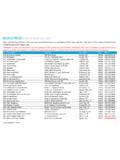Transcription of Comparison of blueberry cranberry and tart cherry
1 Trends and Insights of the blueberry , cranberry , and tart cherry Industries Introduction and Summary Blueberries, cranberries, and tart cherries have a long and storied history. Cranberries are associated with Native Americans and Pilgrims and featured at the first Thanksgiving. Tart cherries are associated with George Washington and the chopping down of the cherry tree. Blueberries were revered among early Northeast Native Americans who used the berries, leaves, and roots for medicinal purposes. Blueberries and cranberries are fruits native to North America. Tart cherries are believed to have come from China and the first cherry orchard was believed to have been planted in the Grand Traverse area in Michigan around 1852 by a Presbyterian missionary.
2 This paper attempts to compare and contrast the marketing of three fruits: blueberries, cranberries, and tart cherries. All three fruits are using or will participate in Federal programs to promote the nutrition and health benefits associated with the consumption of their products. Blueberries use a research and promotion program while cranberries and tart cherries use the promotion authority under Federal marketing orders. The level of bearing acreage seems to indicate that the three fruit industries are very similar in size. However, because of yield, cranberry production is actually much larger than either the blueberry or tart cherry production. However, wild blueberries grown in Maine are not included in the blueberry production used in this analysis because they are excluded from the blueberry Research and Promotion Program.
3 Most of the wild blueberries grown in Maine are processed. One of the striking differences in the three fruits is the large amount of blueberries that are consumed as fresh. Fresh produce generally sells at a higher price than processed fruit. Blueberries have a taste profile that appeals to consumers in both fresh and processed forms. In addition, exports of blueberries are increasing. Presently, fresh exports are greater than processed exports. Tart cherry fresh sales are minimal and the majority of fresh cranberry consumption occurs over the Thanksgiving and Christmas holidays. Fresh blueberries are increasingly available all year. When the domestic crop is out-of-season, imports from Chile and Argentina are featured in supermarkets.
4 The availability of the commodity all year often results in increased per capita consumption. Consumers get in the habit of purchasing the same fruit during each shopping trip throughout the year. blueberry prices and value of production bring to mind similarities to the cranberry situation in the late-1980's and early 1990's. Prices and value of production are trending higher. This will encourage growers to expand production. As long as demand stays strong, growers will be able to operate profitably. However, since blueberries can be grown in a large number of areas and yields are likely to continue to improve; at some point the market may become over-supplied. Generic promotion will likely benefit both the cranberry and tart cherry industries.
5 Export promotion appears to have already assisted the cranberry industry in expanding export opportunities. blueberry promotion appears to have helped spur consumption and may be able to circumvent any possible downturn in the market in the near future. Market research funded by the North American blueberry Council, which administers the Federal research and promotion program, indicates that the perception of health benefits in blueberries can reduce price sensitivity. The perception of value by consumers concerning freshness, taste, and health benefits is the main driver influencing consumer purchases instead of price. Promotion has likely played a large role in influencing consumer awareness and perceptions concerning blueberries.
6 Per capita consumption of cranberries is the highest among the three fruits. Fresh blueberry and processed cranberry per capita consumption is increasing while tart cherry per capita consumption has been decreasing. While the per capita consumption of blueberries is very similar to the per capita consumption of tart cherries, both are somewhat low and have the potential to increase. History of Generic Promotion for Blueberries, Cranberries, and Tart Cherries All three of the fruit industries have been interested in using generic promotion to expand the demand for their products. On December 2, 1998, the North American blueberry Council (NABC) submitted a proposal to the Agricultural Marketing Service of USDA.
7 For a national research and promotion program covering domestic and imported cultivated blueberries. The program, which is authorized by the Commodity Promotion, Research, and Information Act of 1996, became effective on August 16, 2000. Handler assessment obligations began on January 1, 2001. blueberry assessments are paid on highbush (cultivated) blueberries grown in and imported in the 50 states, the District of Columbia, and Puerto Rico. Producers and importers pay an assessment of $12 per ton ($ per pound). The producer assessment is remitted by first handlers, and the importer assessment is remitted by the Customs Service. The NABC uses these assessments and funds from the Foreign Agricultural Service Market Access Program (MAP) to conduct domestic and export generic promotion programs.
8 In 2005 grower and importer assessments totaled $ million per year and MAP funds were $283,065. The cranberry industry implemented a Federal marketing order on August 15, 1962 in response to over-supply and low prices. The primary purpose of the marketing order was to use the volume control authority to limit the delivery of fruit during severe surpluses. The volume controls have only been used five times in the history of the marketing order. During the surplus years of 2000 and 2001, cranberry growers became convinced that promotion under the marketing order should be used as a solution to increase demand in the long run. In the midst of the surplus situation when grower revenues were at their 2.
9 Lowest, the growers decided to increase their assessment by $ per barrel (100 pounds). for domestic generic promotion. The cranberry Marketing Committee (CMC), which administers the Federal marketing order, conducts generic promotions in the United States and uses a combination of funds from the MAP and grower assessments under the Federal marketing order to conduct generic promotion in Japan, Mexico, Germany, France, and Australia. Currently, export sales represent 23% of total sales in the industry. The CMC spends approximately $500,000 a year on its domestic promotion programs. The CMC strategy has been to emphasize the health benefits of consuming cranberry products and to target this information to health-care practioners and health writers/editors as an attempt to influence consumers' awareness.
10 The CMC has also provided print materials to media outlets as an attempt to encourage year around consumption of cranberry products (Sexton). cranberry assessments are paid by first handlers and are only remitted on domestic production, even though a substantial volume of cranberries are imported from Canada. cranberry assessments on growers are currently at $ per barrel. The CMC has recently recommended increasing that assessment to $ per barrel so that it can increase its market promotion programs. Currently, assessments amount to just over $1. million a year for promotion programs and MAP funds are at $998,589. The tart cherry industry first implemented a Federal marketing order program with supply management provisions in 1972.






